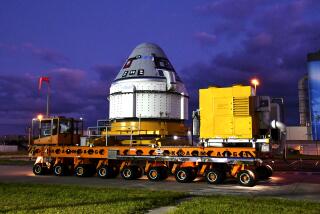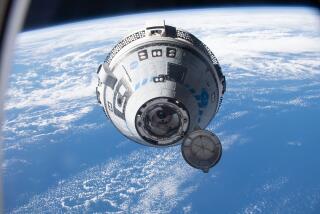Fuel Tank Alterations Clear Way for Shuttle
NASA said Wednesday that recent changes to the shuttle’s external fuel tank should prevent large chunks of insulating foam from falling off and hitting the craft, keeping the next mission on schedule for a possible July 1 launch.
“Based on what we know today, there is no reason not to launch on July 1,” said N. Wayne Hale Jr., manager of the shuttle program.
For the record:
12:00 a.m. June 3, 2006 For The Record
Los Angeles Times Saturday June 03, 2006 Home Edition Main News Part A Page 2 National Desk 0 inches; 28 words Type of Material: Correction
Space shuttle: An article in Thursday’s Section A about fuel tank changes to the space shuttle said Columbia was destroyed on reentry in 2001. It was in 2003.
Speaking at a news conference at Kennedy Space Center in Florida, Hale emphasized that the final decision on the launch would not be made until engineers certified that the remodeled fuel tank was aerodynamically safe and the shuttle passed a flight readiness test two weeks before liftoff.
The launch of Discovery will be the 115th space shuttle mission -- and the second since Columbia was destroyed on reentry in 2001, killing all seven astronauts.
An investigation showed that Columbia was damaged during liftoff by a 1.6-pound piece of insulating foam that came off the external fuel tank and struck the craft.
After the accident, NASA spent several years redesigning the shuttle to make sure no large pieces of foam would fall off. Yet on the next flight -- last summer -- a 1-pound piece of foam flaked off the fuel tank and narrowly missed the orbiter.
NASA grounded the shuttle fleet again. To fix the problem, engineers removed a foam-covered section of the tank called the PAL ramp.
Hale said there was spirited debate among the 100 NASA engineers who gathered for the review this week over whether the removal of the PAL ramp would solve the foam problem.
Some engineers are pushing for the removal of another piece of hardware, called the ice frost ramp, which covers a series of brackets and lines down the side of the fuel tank.
Hale said it would be safer to make one change at a time, rather than several at once. Assuming the next flight goes off without a hitch, the modification to the frost ramp could be made later, he said.
Hale warned, however, that foam will continue to come off the fuel tank. The goal is not to get rid of all of it, but to make sure that only tiny, harmless pieces known as popcorn flake off during launch.
“What we’ve done is eliminate the largest hazards,” he said.
But flying the space shuttle will remain a dangerous enterprise. “This is a 1-in-a-100 vehicle,” said Hale, referring to the odds of a catastrophe occurring on any given mission. “It is a risky vehicle to fly.”
The next Discovery crew will deliver food and water, as well as a new oxygen-producing machine, to the International Space Station.
More to Read
Sign up for Essential California
The most important California stories and recommendations in your inbox every morning.
You may occasionally receive promotional content from the Los Angeles Times.










